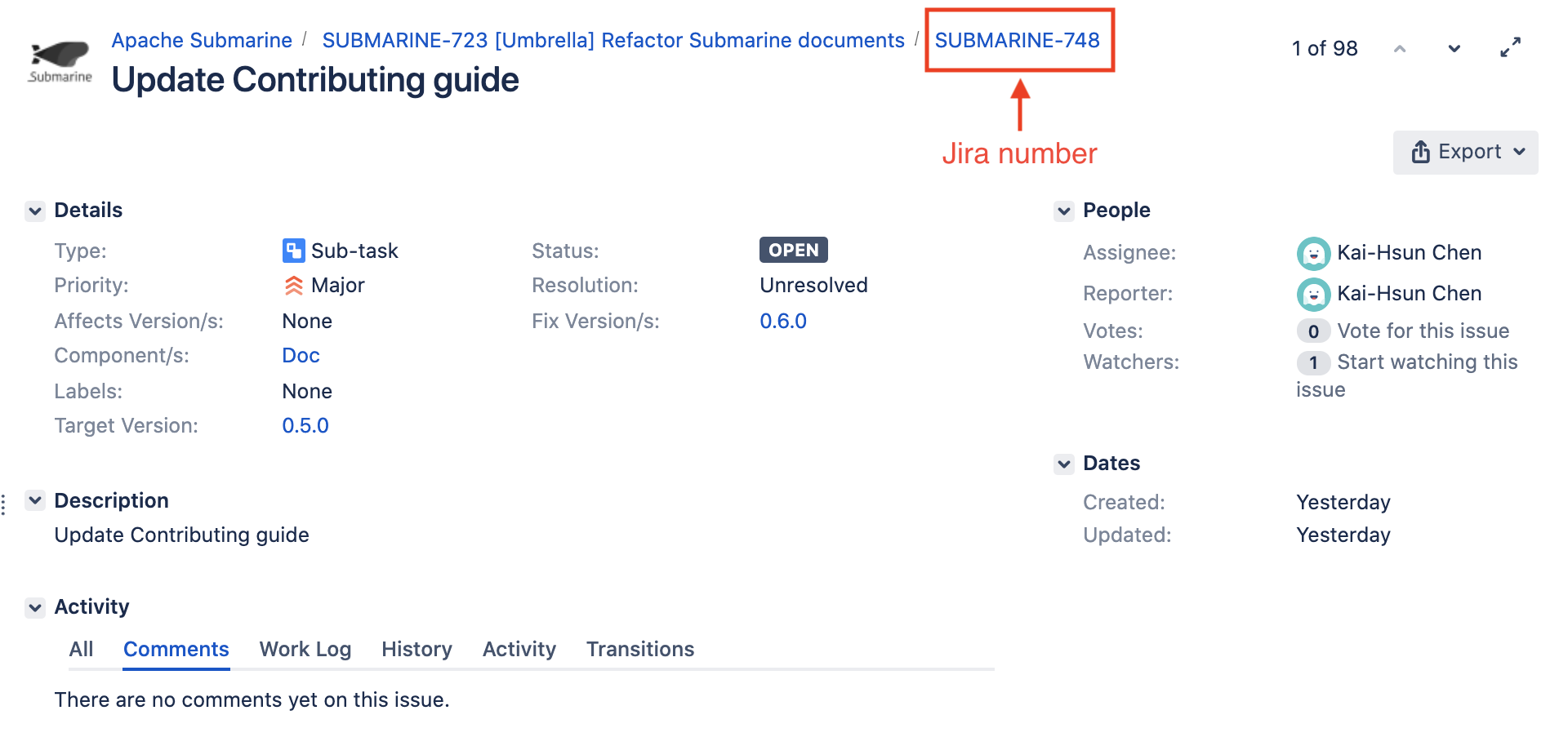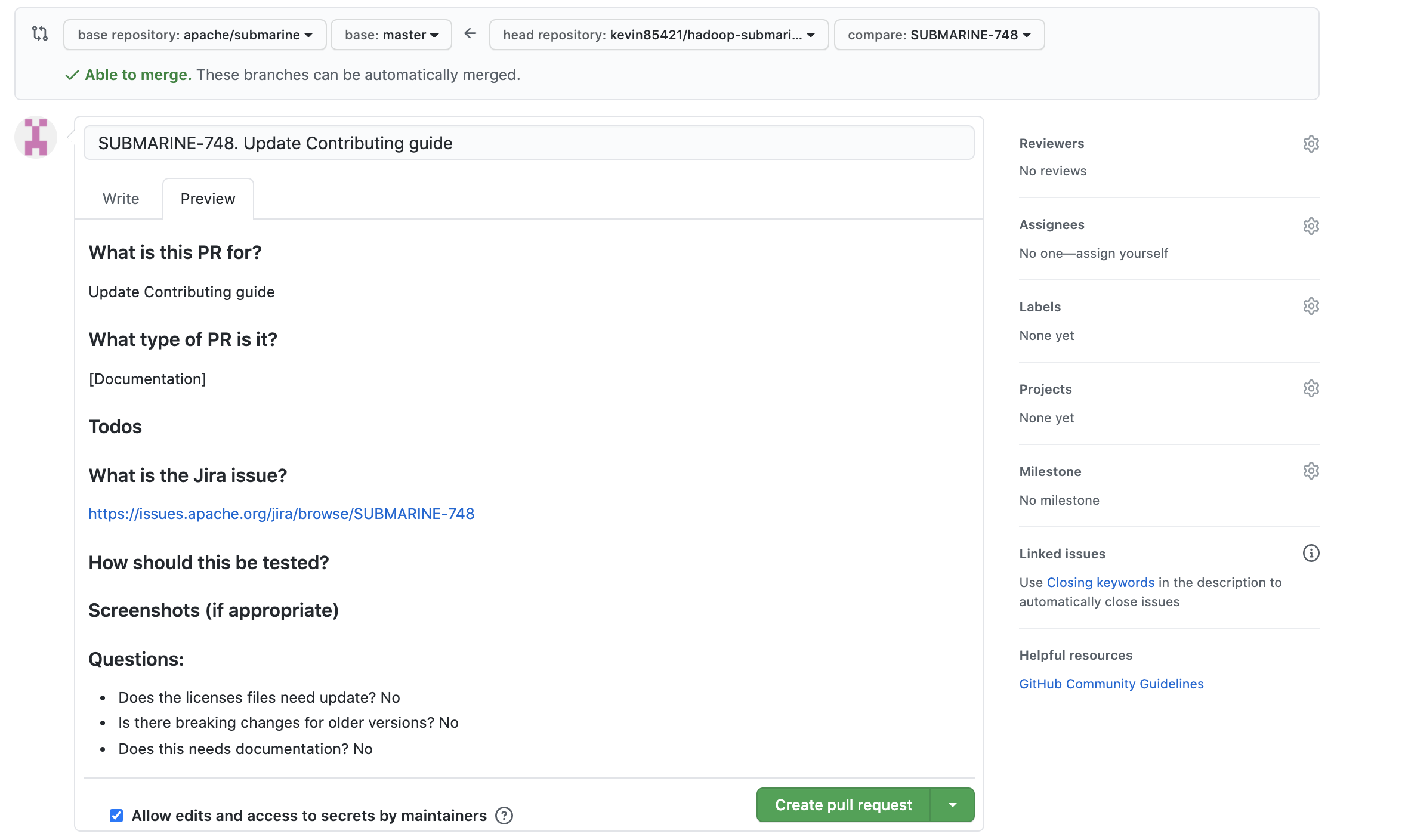How To Contribute to Submarine
There are several ways to contribute to Submarine:
- Develop and Commit source code (This document will primarily focus on this.)
- Report issues (You can report issues with both Github or Jira.)
- Discuss/Answer questions on the mailing list
- Share use cases
Preface
- Apache Submarine is an Apache 2.0 License Software. Contributing to Submarine means you agree to the Apache 2.0 License.
- Please read Code of Conduct carefully.
- The document How It Works can help you understand Apache Software Foundation further.
Build Submarine
Creating patches
Submarine follows Fork & Pull model.
Step1: Fork apache/submarine github repository (first time)
- Visit https://github.com/apache/submarine
- Click the
Forkbutton to create a fork of the repository
Step2: Clone the Submarine to your local machine
# USERNAME – your Github user account name.
git clone git@github.com:${USERNAME}/submarine.git
# or: git clone https://github.com/${USERNAME}/submarine.git
cd submarine
# set upstream
git remote add upstream git@github.com:apache/submarine.git
# or: git remote add upstream https://github.com/apache/submarine.git
# Don't push to the upstream master.
git remote set-url --push upstream no_push
# Check upstream/origin:
# origin git@github.com:${USERNAME}/submarine.git (fetch)
# origin git@github.com:${USERNAME}/submarine.git (push)
# upstream git@github.com:apache/submarine.git (fetch)
# upstream no_push (push)
git remote -v
Step3: Create a new Jira in Submarine project
- New contributors need privilege to create JIRA issues. Please email kaihsun@apache.org with your Jira username. In addition, the email title should be "[New Submarine Contributor]".
- Check Jira issue tracker for existing issues.
- Create a new Jira issue in Submarine project. When the issue is created, a Jira number (eg. SUBMARINE-748) will be assigned to the issue automatically.

Step4: Create a local branch for your contribution
cd submarine
# Make your local master up-to-date
git checkout master
git fetch upstream
git rebase upstream/master
# Create a new branch fro issue SUBMARINE-${jira_number}
git checkout -b SUBMARINE-${jira_number}
# Example: git checkout -b SUBMARINE-748
Step5: Develop & Create commits
- You can edit the code on the
SUBMARINE-${jira_number}branch. (Coding Style: Code Convention) - Create commits
git add ${edited files}
git commit -m "SUBMARINE-${jira_number}. ${Commit Message}"
# Example: git commit -m "SUBMARINE-748. Update Contributing guide"
Step6: Syncing your local branch with upstream/master
# On SUBMARINE-${jira_number} branch
git fetch upstream
git rebase upstream/master
- Please do not use
git pullto synchronize your local branch. Becausegit pulldoes a merge to create merged commits, these will make commit history messy.
Step7: Push your local branch to your personal fork
git push origin SUBMARINE-${jira_number}
Step8: Check GitHub Actions status of your personal commit
- Visit
https://github.com/${USERNAME}/submarine/actions - Please make sure your new commits can pass all workflows before creating a pull request.

Step9: Create a pull request on github UI
- Visit your fork at
https://github.com/${USERNAME}/submarine.git - Click
Compare & Pull Requestbutton to create pull request.
Pull Request template
- Pull request template
- Filling the template thoroughly can improve the speed of the review process. Example:

Step10: Check GitHub Actions status of your pull request in apache/submarine
- Visit https://github.com/apache/submarine/actions
- Please make sure your pull request can pass all workflows.
Step11: The Review Process
- Anyone can be a reviewer and comment on the pull requests.
- Reviewer can indicate that a patch looks suitable for merging with a comment such as: "Looks good", "LGTM", "+1". (PS: LGTM = Looks Good To Me)
- At least one indication of suitability (e.g. "LGTM") from a committer is required to be merged.
- A committer can then initiate lazy consensus ("Merge if there is no more discussion") after which the code can be merged after a particular time (usually 24 hours) if there are no more reviews.
- Contributors can ping reviewers (including committers) by commenting 'Ready to review'.
Step12: Address review comments
- Push new commits to SUBMARINE-${jira_number} branch. The pull request will update automatically.
- After you address all review comments, committers will merge the pull request.
Code convention
We are following Google Code style:
There are some plugins to format, lint your code in IDE (use dev-support/maven-config/checkstyle.xml as rules)